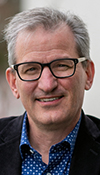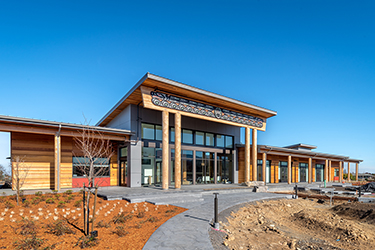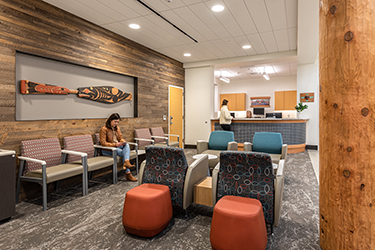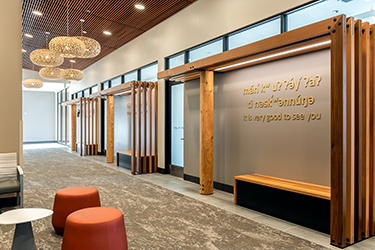|
Subscribe / Renew |
|
|
Contact Us |
|
| ► Subscribe to our Free Weekly Newsletter | |
| home | Welcome, sign in or click here to subscribe. | login |
Construction
| |
 |
April 1, 2022
Designing a healing river in Sequim
Rice Fergus Miller

Webber
|

Belding
|
Across the United States, more than 10 million people misuse opioids annually, and more than 50,000 people die from opioid overdose. Studies have found that of those, Native Americans have the highest per capita rate of opioid overdose deaths of any population group. It’s no wonder then that tribes are celebrating the recent $590 million settlement with drug distributors over the damage opioids have caused in their communities. But long before these reparations came to fruition, tribes started strategizing ways to combat this epidemic.
CLINIC TAKES ROOT
In Sequim, the Jamestown S’Klallam Tribe (JST) has just opened its new healing clinic, the first phase of a larger planned healing campus. This much-needed contribution to Clallam County and the greater Olympic Peninsula will treat up to 300 individuals a day — and not just tribal citizens — who are suffering from substance use disorder and related health and wellness challenges. Designed by Rice Fergus Miller, this new facility offers much more than a typical medication dispensary.
The downfall of many methadone dispensary facilities is that they fail to treat the underlying issues that may have led to addiction in the first place — instead focusing efforts simply on providing medications that prevent ongoing withdrawal symptoms after quitting substances like fentanyl, heroin, or prescription pain pills. For many, simply getting to a dispensary is a feat, leaving little time or ability to seek basic health care services. The Jamestown S’Klallam Healing Clinic was designed to solve this challenge, helping tribal patients and members of the greater community greatly reduce their chances of relapse.
THE WHOLE PERSON
The philosophy behind clinics that provide “wraparound services” is to treat the whole person. While patients are receiving their doses, they can be seen by a primary care doctor, dentist, or mental health counselor, and childcare services are available for those with children. Additionally, a shuttle is provided for patients without transportation. The goal is to reduce barriers to accessing treatment for holistic healing.
Clinics with this approach have been shown to produce impressive results. One such clinic for the Swinomish Indian Tribal Community has been very successful. Over a 12-month period from 2018 to 2019, it nearly reached client capacity, its client retention rate was over 75%, and opioid overdose deaths among Swinomish Tribal members dropped by 50%. Clearly, patients are less likely to relapse when receiving holistic care that helps them get their lives back on track to a healthy condition.
According to Dawn Lee, a planning consultant who worked with Rice Fergus Miller and Jamestown S’Klallam Tribe on the new JST Healing Clinic, “Breaking down barriers for clients is the best way to ensure that clients can meet their individual treatment needs. By offering transportation and childcare, patients can safely get to the clinic without worry, and begin focusing on their treatment goals. Giving the client all the tools and understanding necessary to be successful sets them up for their best chance at recovery, that’s why this model works. Patients have a lower success rate if we refer them outside of the clinic for other services.”
CULTURAL STYLE
The design of these healing clinics is about much more than a pharmacy walk-up window and requires navigating complex medical-planning challenges. Not only is the JST clinic a highly protected facility with security personnel on site at all times, it contains a dental clinic, medical exam rooms, a pharmacy, and childcare facilities.
Most patient visits are routine, planned and protective of confidential personal information. Some patients may arrive at the clinic in an emergency scenario needing urgent access to health and/or dental care services. Medical staff are trained to provide comprehensive patient care, and facilities must conform to strict DEA requirements, which necessitate specialized knowledge and information that must be integrated into the design.
The aesthetic of the building is heavily inspired by forms found in traditional Pacific Northwest American Indian architecture. The geometries and materials used are meant to reflect a modern interpretation of these culturally significant designs.
Long planar elements and shallow sloped roofs with deep overhangs are reminiscent of the structures once built by local tribes. Cedar wood cladding is the primary exterior material on the building, and it is oriented horizontally with two distinct widths and depths as a modern interpretation of this local material. A local artist was commissioned to create the traditional tribal art patterns that frame the main entry, as well as art found throughout the interior of the project.
A MODEL
Unfortunately, medication-assisted treatment (MAT) facilities sometimes face opposition due to a lack of understanding about what these services truly offer to the community.
That was initially the case for the JST Healing Clinic. “Sometimes, optically, people think that these kind of treatment centers become a magnet to drug dealers and the underbelly of that industry,” said Jamestown S’Klallam Chairman W. Ron Allen. “That’s not what it is. It’s the opposite of that perception. These facilities are designed to be highly secure, highly safe, highly monitored and totally focused on helping those individuals become healthy.”
Thanks to a series of public outreach meetings and education with the Sequim community about the benefits of clinics with wraparound services, the project was able to move ahead. Allen and other JST officials raised funds through Washington state monies earmarked for MAT facilities, as well as the tribe’s own contributions.
While a number of these facilities are underway in communities around Washington state and beyond — Rice Fergus Miller is also designing MAT clinics for the Nisqually and Quinault Nations — the healing clinic model is viable for all rural communities around the country. They can be of benefit wherever access to health care is more difficult to come by than narcotics. They can mean saving the lives of tribal citizens, and the lives of many people in the community at large.
PATH TO RECOVERY
While other similar projects are underway in Washington state, each project requires a separate set of considerations and modifications to meet the nuanced needs of each tribe’s culture and each community they serve. These facilities can be difficult to operate and hard to justify financially without the proper balance of scale and program elements. An experienced team with the right expertise is essential.
“I’m proud of this contribution to our community and so grateful the clinic is finally open,” said Allen. “This has been a long time coming, and our brothers and sisters have been waiting for this care. I know we’re going to save a lot of lives.”
All American Indian tribes have deep connections to storytelling and lore, and the design of the JST facility incorporates a story with significant meaning for the tribe’s culture and history. It’s about changing the path of a river by moving just one stone. This new healing clinic will serve as exactly that for many tribal and community members who utilize its services: The first step toward healing.
The hope is that other health care facilities follow this model. By lowering barriers and providing wraparound services that treat the whole person, deeper, longer-lasting healing can take place.
Blake Webber is an associate principal at Rice Fergus Miller and leads the firm’s health care studio. Greg Belding is a principal at Rice Fergus Miller.
Other Stories:
- A boost for health care education at Bates Tech
- Don’t ignore new compliance requirements
- The lab building of the future is NEXT
- What it takes to build health and science projects
- The challenge of fighting climate change Health
- It’s time to rethink health care design
- A cancer care model with all the right amenities





